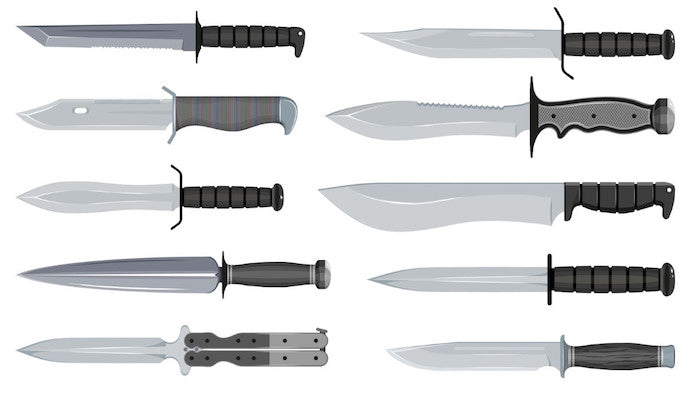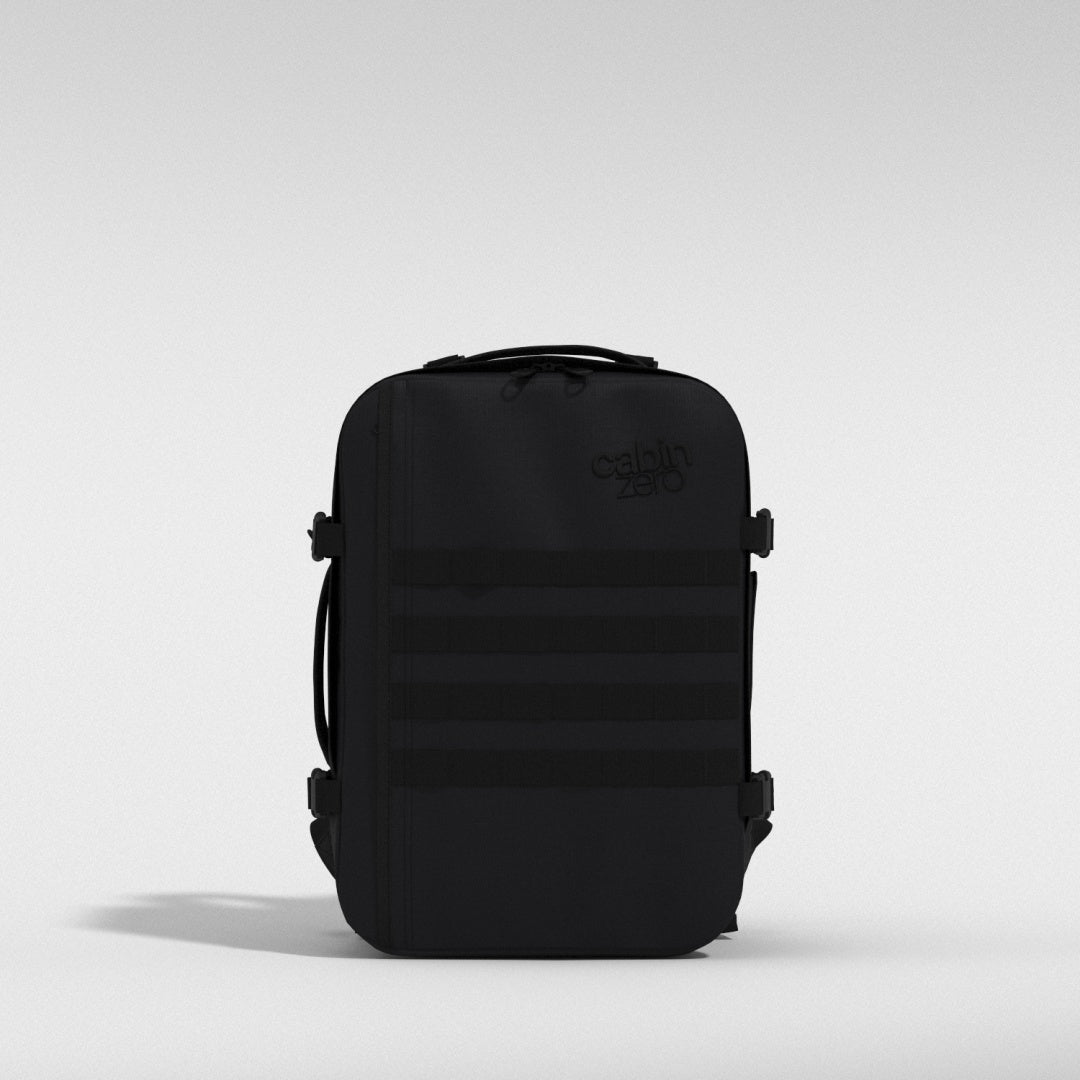CONTENTS
Can You Bring Knives On Planes: Airline Rules You Need to Know
If you're planning to travel by aeroplane, you may wonder: Can you bring knives on planes? The answer is not as simple as a "Yes" or "No", as there are specific regulations and restrictions you need to be aware of.
In this article, our team at CabinZero will explore the TSA regulations on carrying knives in your luggage when flying. We'll also cover what types of knives are allowed on planes, the specific exceptions to the Prohibited Items List, and recommend valuable tips for safely packing knives in your checked luggage.
Whether you're a chef travelling with your kitchen knives or a hobbyist with a pocket knife, you should have a deep insight into the matter. By following these rules, you can enjoy a smooth and hassle-free flight while keeping yourself and other passengers safe.
Can You Bring Knives On Planes?
Yes, you can bring knives on planes, but with a few restrictions on types and packing. In the United States and European nations, TSA prohibits knives in carry-on luggage, except for plastic or round-bladed butter knives. However, blades can be packed in checked baggage if they are sheathed or securely wrapped to deter injury during air travel.
Current UK law states: “carrying knives or any weapons in public without a ‘good reason’ is illegal”. So it’s understandable that airlines enforce strict rules on bringing such items on flights.
Sharp or pointed blades over 6 cm are not allowed in hand luggage in the UK. But you can pack them in hold luggage after consulting with the airline.
Additionally, bladed tools such as box cutters in carry-on luggage are banned. However, certain items like straight razors are still allowed if packed in a specific way.
TSA Guidelines for Packing Sharp Objects in Checked Luggage
The TSA (Transportation Security Administration in the USA) has the following regulations on its website with regard to the limitations on sharp objects in carry-on luggage:
“TSA officers have the discretion to prohibit any item through the screening checkpoint if they believe it poses a security threat. Any sharp objects in checked bags should be sheathed or securely wrapped to prevent injury to baggage handlers and inspectors.”
TSA guidelines for packing sharp items in checked luggage include:
- Use a sturdy container or protective sheath to prevent the sharp object from damaging other items in your luggage or injuring baggage handlers.
- Wrap the sharp item in a soft material, such as clothing or bubble wrap, to prevent it from shifting or jostling during transport.
- Declare any sharp items or potential weapons, including tools or sporting equipment, to the airline and TSA agent at the security checkpoint.
- Failure to declare sharp items or other prohibited items could result in fines, delays, or even criminal charges.

TSA guidelines for packing sharp items in checked luggage - Photo by Dental Pro Content - stock.adobe.com
TSA also imposes civil penalties on individuals who bring sharp items, including knives, through airport security checkpoints, sterile areas or onboard aircraft. The amount of the fine can vary from $390 to $2,250. In addition to the civil penalty, the TSA may refer the matter to law enforcement for possible criminal prosecution.
Note: Always check the TSA website or mobile app for the most up-to-date information on prohibited items and restrictions on sharp objects. Regulations may vary based on airline, destination, or other factors.
Types of Knives Allowed in Checked Luggage
You're a traveller who enjoys outdoor activities such as camping or hunting. You may want to bring along a knife for such purposes. While knives are generally illegal to bring in carry-on luggage, certain types are permitted in checked baggage.
- Fixed Blade Knives: These knives have a blade permanently attached to the handle. They are allowed as long as the blade is within 7 inches. They are allowed because they are considered tools and used for various purposes, such as camping, hunting, and fishing.
- Folding Knives: These knives have a blade that folds into the handle. Folding knives are allowed, providing the blade is no longer than 4 inches.
- Pocket Knives: These knives are commonly utilised as tools for outdoor activities like camping, fishing, and hunting, as well as for day-to-day tasks such as opening boxes or cutting loose threads. For this reason, they are not inherently hazardous and are not perceived as a risk to airline security.
- Kitchen Knives: These knives are essential tools for cooking and are commonly used in households and professional kitchens. While they can be dangerous if not used properly, they are not inherently a security threat and are unlikely to be used as weapons on board an aeroplane. However, certain kitchen knives, such as those with serrated or curved blades, may be subject to additional scrutiny by some airlines or destinations.
- Multi-tools: These tools have numerous functions, including knives, and are permitted provided that the blade’s length does not exceed 2.36 inches.
- Note: Remember that any knife with a blade longer than the specified lengths above is strictly banned in checked luggage. Additionally, any knife that is deemed to be a weapon, such as switchblades or daggers, is prohibited in both carry-on and checked luggage.
Types Of Knives Prohibited On Planes
Certain knives can be deemed unfit depending on their blade size, structure, and other factors. If you were to carry one of these knives in your checked luggage during air travel, the airport security officer would probably contact the relevant authorities. You could face legal consequences.
The regulations can be intricate and vary from country to country. We have gathered a list of knives that are generally considered outlawed by most governing bodies.

Certain knives can be deemed against the law - Photo by avtorpainter - stock.adobe.com
- Switchblades: These knives have a blade that can be quickly released with the push of a button. They are banned on planes because they are considered to be weapons and can be used to harm others.
- Balisongs or butterfly knives: The blade of these knives can swing out from the handle. You must not bring these on planes because sometimes they are believed to pose a security threat.
- Disguised knives: These knives are designed to look like other objects, such as a pen or a belt buckle. They are not permitted on planes because they can be easily concealed and used to injure others.
- Throwing stars or ninja stars: These throwing weapons are prohibited from being carried on planes due to their potential to harm others.
- Straight razors: Their non-retractable long sharp blades can be used as weapons.
- Swords or sabres: Most countries prohibit sharp weapons such as swords, sabres, and even spears.
Tips for Safely Packing Knives in Checked Luggage
According to airline security regulations, all travellers must securely pack knives in their checked baggage. You must shield the blade to prevent unintended harm when people handle or inspect the luggage.
If you fail to safely pack a knife and a security officer sustains injuries as a result, you may potentially encounter legal action.

How to Pack Knives in Checked Baggage - Photo by vzwer - stock.adobe.com
Therefore, we have recommended various tips for safely packing knives in checked luggage, which are:
Choose The Right Luggage
When packing knives, choose sturdy and durable luggage with a hard shell. This will help protect your knives from damage during transit and will also help prevent them from being lost or stolen.
Pack The Knives Separately
When packing multiple knives, pack them separately in their own protective covers or sheaths. This will help reduce the possibility of scratching or damaging them during transit. To take it further, you may want to put it in a separate bag for additional safety measures.
Use Tape To Secure The Sharp Edge
Tightly encircle the blade with paper or napkins to create a barrier between the knife and the adhesive portion of the tape. This will ensure that the blade remains free of any sticky residue. The next step is to cover the knife with duct or masking tape to secure everything in position.
Pack The Knife In The Middle Of Your Luggage
Place the knife in the centre of your baggage, enveloped by gentle objects like clothes or towels. This will offer additional padding and also prevent the knife from moving around while being transported.
Keep Your Luggage Locked
Use a TSA-approved lock to secure your luggage, especially if it contains knives or other sharp objects. This will help hinder theft and will also allow TSA agents to inspect your luggage without damaging it.
Place The Knife In A Hard-Sided Container
This will offer supplementary protection for the knife and will also ensure the safety of your baggage in case the knife accidentally pierces through something.
FAQs
1. What Is The Maximum Size Knife I Can Carry In Hand Luggage?
It's difficult to give a definitive answer on the maximum size knife you can carry, as it varies depending on the airline and country you are travelling to and from. TSA used to allows knives with blades that are 2.36 inches (6 cm) or less in length in carry-on. However, that is a thing of the past. Now they ban all knives in hand luggage and on your body. You can only check them in.
2. Can I Take A Metal Knife On A Plane?
As a general rule, metal knives are not allowed in carry-on baggage on aeroplanes. This includes both sharp and blunt knives, regardless of size.
However, metal knives may be packed in checked baggage, provided that they are securely wrapped or placed in a sheath to prevent injury to baggage handlers and inspectors.
3. What Other Sharp Items Am I Prohibited From Taking With Me When Travelling By Air?
In addition to knives, there are other sharp items that are prohibited or restricted when travelling by air to the UK. These include:
- Razor blades, including safety razor blades and disposable razors with blades.
- Scissors with blades exceeding 6 cm in length.
- Hypodermic needles (unless required for medical reasons and accompanied by a prescription).
- Tools with blades or shafts capable of being used as weapons, such as screwdrivers, chisels, and drills.
- Sporting equipment with sharp edges or points, such as ice axes, crampons, and archery equipment.
Note: Apart from sharp items, there are several objects you can’t bring on a plane according to TSA regulations.
4. What Should I Do If I Accidentally Pack A Prohibited Knife In My Luggage?
In case you mistakenly pack a knife that is not allowed in your luggage, it is essential to notify the airport security or airline promptly. Do not try to hide or sneak the knife from security. There could be repercussions, such as the confiscation of the knife or additional screening.
However, being honest and cooperative can help resolve the situation with minimal disruption. In some circumstances, you may be able to check the knife as a separate item or arrange for it to be shipped to your destination separately.
5. What Is The Fine For Bringing A Knife Through Airport Security?
The penalty for carrying a knife through airport security can differ based on factors such as the knife type, location, and intention of the person carrying it. In the US, fines may range from a few hundred dollars to thousands of dollars for repeated violations. The amount of the fine may be determined by either the TSA or a court. Moreover, bringing a prohibited knife through airport security could result in legal action, including arrest.
Can You Bring Knives on Planes: The Final Answer
After reading this article, we hope you have gained a better understanding of whether or not you can bring knives on planes. It's crucial to remember that knives are only permitted in your checked luggage on all airlines. Additionally, be aware that certain destinations may have restrictions on specific types of knives.
Ultimately, whether you're a seasoned outdoorsman or a handy DIY enthusiast, follow the rules to bring your favourite knife with you on your next flight. So, pack smartly, stay informed, and have happy travels!
Hà Phạm























Много раз, включая 2024 год, я провозил в ручной клади складной Victorinox 58 мм с клинком, пилкой для ногтей и ножницами. Но в 2006 году у меня изъяли именно такой в аэропорту Шарль-де-Голль в Париже
In the US, they have the experience of over 3000 deaths caused by hijackers armed with very small blades on box cutters. Smaller than a pocket knife. The US also gets far more traffic than any individual European country. it’s no wonder they are more strict when it comes to the type of blades that can be brought on board.
I discovered by accident that standard size penknives are permitted or flights to and from Canada to Ireland. I found that my 91mm Swiss Army knife with a 60mm blade was allowed. Security measured the blade and dropped it back in the tray. I was told that it would have been seized if I was going to the USA.
Prohibition of carrying small pocket knives, say blades less that 2 inches, on an aircraft is absolutely ridiculous. When a lady wants to knit she can take the needles, a ball point pin can be used to kill or injure, the list could go on and on, but NO, not a small knife. I traveled recently through 3 different airports in Europe and was allowed to carry onboard a small Swiss Army knife. That being the case I presume they just have more common sense than those who make the rules in the US.
Leave a comment